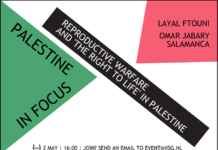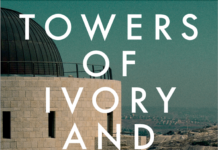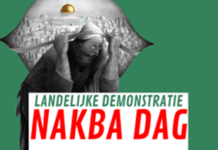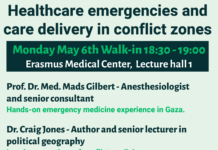Mohammed al-Kurd
The Nation / September 15, 2021
For months, the people of Beita have been engaged in a fierce—and fiercely creative—struggle against the illegal Israeli settlement threatening their village.
BEITA, PALESTINE—The clock is nearing 10 at night. It’s a Sunday evening in August, and the people of this Palestinian village in the northern occupied West Bank are gathering at Mount Sabih, where an illegal settler outpost was erected in early May. They are preparing for what they call the “nightly disruptions,” a resistance ritual that has been unabated and evolving for over a hundred days. Its goal is to sour the settlers’ stay in their lands.
More than a hundred people have gathered at the top of the mountain this evening. Children prance about with makeshift torches. Men nearing their 80s sit cross-legged on big rocks and point bright-green laser beams at the outpost. Some young people practice with their slingshots. Some burn tires. Some chant. Every now and then a distant explosion is heard, sometimes from an Israeli sound bomb, sometimes from an exploded industrial barrel that the defenders use to surprise soldiers. A man walks around offering the crowd coffee and water. There is some laughter. Then quiet descends as the Defenders of the Mountain arrive at the scene.
“We are the sons of Beita, the Defenders of the Mountain,” says one of them, likely in his early 30s, his face wrapped in a keffiyeh to conceal his identity. “We are defending ourselves and our lands against the settler gangs that came to steal them with the protection of the Occupation soldiers and their fascist state.”
A few cameras record the defender’s speech, which echoes, in some ways, a familiar Palestinian refrain: He spells out the necessary distinctions between the colonizer and the native and condemns the media’s role in obfuscating an explicitly asymmetrical reality. “We have not fired one bullet while the occupying power fired thousands,” he says.
As he finishes, the defenders march onwards, chants thundering.
Ihad traveled to Beita—a couple of hours and military checkpoints away from my home in Sheikh Jarrah—out of an intense urge to see this nightly ritual for myself. The protest movement in modern-day Beita is reminiscent of Palestine’s First Intifada, and the images out of the village today mirror those from the 1980s: denim-wearing youth burning tires and throwing stones, marching bare-chested toward soldiers armed with impunity and US weaponry.
Like thousands of people, I had been following their story on social media, where the #SaveBeita campaign has gained traction and cultivated massive support for Beita’s mountain defenders. Mainstream media, on the other hand, has tended to ignore the story—until, that is, Israeli troops inevitably kill a resident of the town. Palestinians are in headlines only as victims or villains, seldom as freedom fighters with political agency. “They only like us when we do soft resistance,” one community member told me as he offered a cigarette. “We do rough resistance here.”
This model of resistance merits its own headlines. It is relentless, communal, and unabashed. It has also tipped the scales in a seemingly impossible situation. In July, settlers evacuated the location in response to the nonstop protests. While the settlers’ mobile homes remain intact and heavily guarded, and the Israeli regime is weighing whether to declare the land a state-owned military zone, the people of Beita have vowed not to stop resisting until Mount Sabih is liberated.
When I spoke to people in Beita about their resistance, I often heard answers that made it sound as simple as it was instinctive—despite threats of arrest and death. “Defending our land is in our blood, it’s passed down from generation to generation,” said one Beita native by way of explaining the village’s enduring stand against both soldiers and settlers. “Our parents fought and sacrificed so much [to keep our lands]. We cannot fail them.”
Still, there is no denying that the price of Beita’s resistance has been high. The Israeli occupation authorities have responded to the village’s protests with mass arrests and violent crackdowns, killing seven Palestinians, including two children. According to Dr. Mohammad Al-Adel of Rafidya Hospital, Beita’s nearest hospital, Israeli forces have injured over 3,000 Palestinians in Beita since the protests started, many with live ammunition. Soldiers have been documented repeatedly attacking ambulances.
Even so, the town, according to the nearly dozen people I spoke with, seems to support the protests, fully and unanimously, marshaling their resources toward the shared project of defending the mountain. People use minarets to alert their neighbors of settler and army raids, much as they did during the days of the First Intifada. Families will cancel their weddings and parties if someone is killed. The town collectively mourns its martyrs. Protesters have not stopped going to the mountain for over a hundred days. And instead of celebrating passing Tawjihi (standardized high school tests), this year’s graduates gave their fireworks to the Defenders to use in the nightly disruption activities.
At the core of this resistance is a mix of discipline and creativity. The Defenders of the Mountain are divided into non-hierarchical units, which employ various tactics to disturb settler activity at the outpost: the Rubber Unit, which burns tires; the Horns Unit, which blasts loud sounds; the Laser Unit, which flashes lights; the Scouting Unit; and the Fireworks Unit. They even had a Barber Unit that gave people free haircuts at the mountaintop. And the town’s children have contributed, too. “The Torches Unit—a 12-year-old came up with that one,” a man tells me.
A few nights before my visit, some young people managed to get their hands on some tear gas left behind in an unlocked police car. They created what one defender called a “primitive but useful” canister to throw back at the soldiers. All of those details outline Beita’s “rough resistance” as simply an unfiltered, natural response to subjugation.
Over the years, “rough resistance” elsewhere in Palestine has largely been defanged by decades of demonizing and misrepresentation. When the slayer is the one who gets to answer the questions about the slain, uprisings become “clashes,” stones become equivalent to automatic weapons, resistance is smeared as terrorism, and history and context are swept under the rug. But, this summer, Beita has reclaimed the image of the Palestinian freedom fighter for itself—and reintroduced it to those who were watching.
Beita’s story goes at least as far back as the Nakba, with numerous moments of incursion and insurgency in the decades that followed. “This is not a new concept,” one defender told me while we sat under an olive tree and watched old men shine their lasers at the colony. The defender had grown up visiting his older brother in an Israeli prison, while his younger brother now sits in an Israeli jail, arrested for protesting the settler outpost. “We’ve lived this all of our lives.”
The night I visited, the years of the First Intifada came up again and again. The people of the village became some of the first victims of Yitzhak Rabin’s “break the bones” policy when, in early 1988, the Occupation Forces raided Beita and arrested 25 Palestinians for participating in the Intifada. The soldiers beat them with batons and rifle butts until they broke their limbs. “I thought the hour of my death had come,” recalled 57-year-old Ribhi Hamdan, who was among those brutalized.
Not long after, on April 6, 18 settlers—two of them armed, one with an Uzi another with an M16—marched down to the village from a nearby settlement. The mosque’s minaret warned of the raid. When villagers surrounded the settlers, the settlers shot indiscriminately and killed two Palestinians. Infuriated, the villagers attacked the settlers with sticks and stones and wounded some. One settler was accidentally killed by friendly fire.
In “response,” the Israeli military sent tanks, bulldozers, and hundreds of soldiers to Beita. The occupation forces blew up 14 Palestinian homes, uprooted dozens of trees, shot one Palestinian to death, detained hundreds, and exiled six men to Lebanon—two of whom are still not allowed to return. This military operation lasted four days.
It is not hard to imagine how the occupation’s cruelty can create such courageous people. The victims of Rabin’s brutal crackdown would then become the fathers and grandfathers of today’s mountain rangers. Their broken bones didn’t constitute broken spirits.
It was out of this history that the Defenders of the Mountain first crystallized as a group in 2018. That year, settlers made one of several attempts to take control of El-Urma, another of Beita’s mountains. The settlers failed, thanks to Beita’s protests, but the spirit of vigilance endured; the town continued to deploy guards to watch for any signs of settler activity.
This is the reason Palestinians were ready when army-backed settlers occupied their mountaintop in early May and erected caravans on lands that belong to the people of Beita and two other villages—Yatma and Qabalan. Like so many other Israeli colonies, this one separated the villages from each other, severing social and economic ties, and preventing any future natural community growth.
Situated high above the villages, it lurked over them, an ever-present reminder of their looming displacement and the constant possibility of violence against their homes and businesses. It was a clear violation of both international and Israeli law, but that didn’t stop the Israeli government from paving its roads and providing it with electricity.
“We see what settlers have done to other villages. A settler can set a Palestinian house on fire and walk away,” said Baraa Hussein, a 23-year-old photographer, referring to the 2015 burning of the Dawabsheh family in the nearby village of Douma, which killed all but one of the family members. “We don’t want that to be our reality.”
This desire to live free of the threat of settlers—to live in their village, unsurrounded and unthreatened—is so strong that people in Beita are willing to face death for it. On July 27, 25-year-old Amjad Hamayel survived a near-fatal attack by Israeli Occupation Forces on the mountaintop. I visited Hamayel, who had become somewhat of a local hero, to understand the extent to which the troops targeted protesters.
On the afternoon I arrived, he was sitting on a twin bed in the unfinished top floor of his parents’ apartment, a floral blanket covering his wounded leg, his crutches resting against the wall. His window overlooked the mountain. Around his bed, several guests sat on plastic chairs, listening attentively, interrupting only to offer historical context here and there.
“We were holding a Palestinian Heritage event at the park across from Mount Sabih. There weren’t even confrontations or anything,” Hamayel recalled. “I was surprised to feel the first live bullet near my ear.”
That first bullet was quickly followed by others. As Hamayel attempted to escape toward the medics, one of them hit his leg, pulverizing his arteries and muscle tissue. As Hamayel would later learn, that bullet was a 0.22 caliber, nicknamed “two-two bullets,” from a Ruger rifle, which is made in the United States. The bullets often ricochet inside a human body and can be lethal, notwithstanding Israeli claims that they are “nonlethal.” “They want to paralyze all of Beita’s youth,” he said.
Hamayel’s father interrupted to ask if I could stomach the pictures of the injury. He leaned in and showed me images. “Blown up” is perhaps the only suitable adjective for the visual of his leg.
Israeli soldiers “shoot to maim,” aiming at the legs so that one can never physically resist again—a refined continuation of Rabin’s bone-breaking legacy, replacing rifle butts with snipers. During the 2018 March of Great Return, 87 percent of the live-ammunition wounds affected the lower limbs, according to the World Health Organization. It’s a way the Israeli regime can create a permanently paralyzed or disabled population all while avoiding accusations of mass killings.
In Hamayel’s case, the doctors believed his leg would likely need to be amputated. “The doctor told my parents my leg was like a ‘withered rose,’” Hamayel said. “You can try watering it and hope that it blooms again.” And yet, remarkably, the surgery the doctors performed was a success. Hamayel is now looking forward to finishing physical therapy—and “cannot wait to return to the mountain.”
“There is nothing to fear,” he said of his decision to go back to the site of his near-death.
“Well, there are bullets,” I argued.
He laughed.
On the same day that Hamayel was shot, Israeli forces killed 41-year-old Shadi Salim, the village’s water engineer. Locals said that the Israelis routinely cut off the water as a means of collective punishment, and Salim was shot as he returned from work, attempting to provide the village with water. Salim’s killers claimed he was “advancing rapidly” toward them “with a suspicious object.” The Israeli authorities held his body hostage and used it as a bargaining chip for over two weeks. (This is a common practice used to pressure communities into submission, which the Israeli Supreme Court has deemed legal.)
Still, the Defenders of the Mountain keep marching. They do not care how they are interpreted; they do not perform for an audience. The resistance here is rough, and neither Zionist repression nor ethnocentric Western guidelines can dull it. The defenders understand that sainthood is no longer a prerequisite to international solidarity, so they march and chant without shame. They corral the town, tires ablaze on their shoulders, and the minarets announce an uprising.
When compared to the Israeli military, the Defenders of the Mountain don’t have much going for them in this battle. What’s a slingshot to a sniper? But to look a rifle in the eye and still say your truth is to be a giant. The Defenders own this narrative, despite the livid TV pundits and the cowering diplomats whispering in their ears.
“You don’t forget about the mountain,” one defender told me. “When something is rightfully yours, you fight for it.”
Mohammed al-Kurd is the Palestine Correspondent for The Nation; he writes primarily about dispossession in Jerusalem and colonization in Palestine; his debut book, RIFQA (Haymarket Books), will be released in October 2021.












